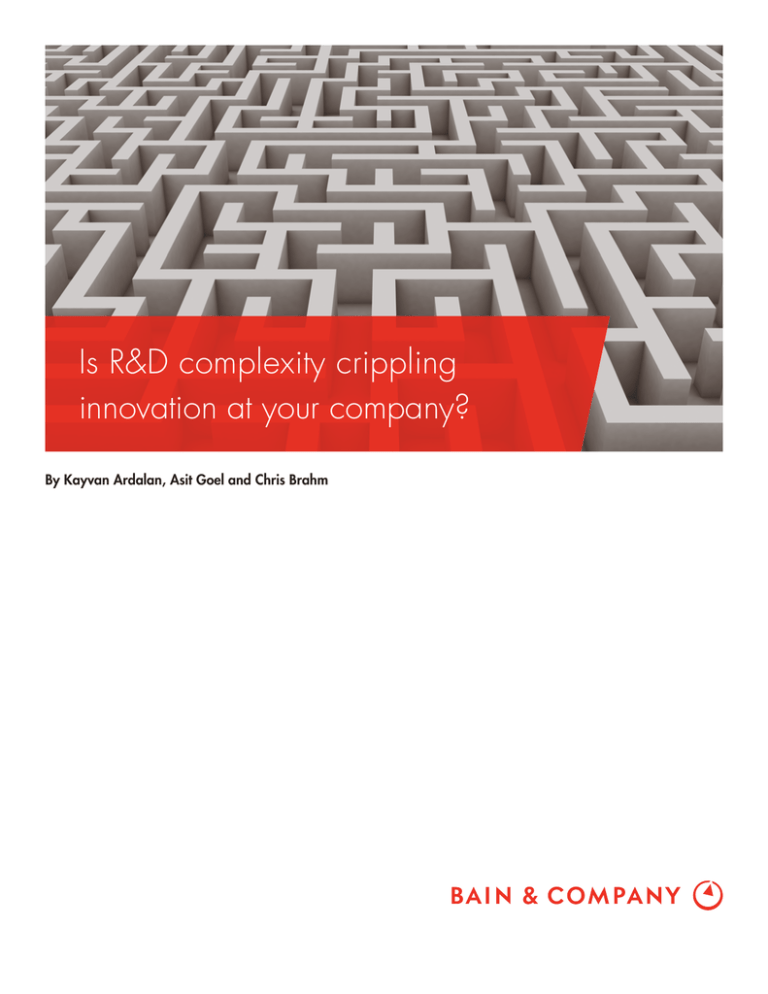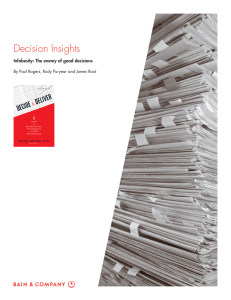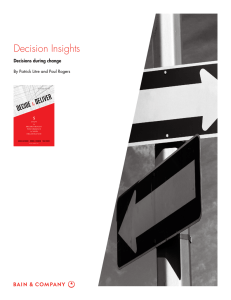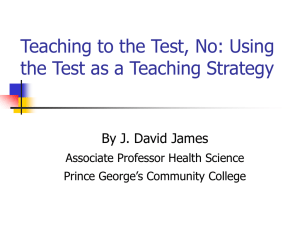
Is R&D complexity crippling
innovation at your company?
By Kayvan Ardalan, Asit Goel and Chris Brahm
Kayvan Ardalan is a partner with Bain & Company in Los Angeles, where he
is a leader in the firm’s global R&D/Product Development practice. Asit Goel
is a Bain partner in Palo Alto and the leader of the firm’s North American
R&D/Product Development practice. Chris Brahm is a partner in Bain’s San
Francisco office; he leads the firm’s Technology practice in North America.
The authors would like to acknowledge the contributions of Michael C. Mankins,
a partner with Bain & Company in San Francisco, and Patrick O’Hagan, a
Bain partner in Boston.
Copyright © 2013 Bain & Company, Inc. All rights reserved.
Is R&D complexity crippling innovation at your company?
Innovation is a top priority for most companies. But few
Highly innovative organizations manage these pressures
leaders believe their companies are effective at inno-
very differently. They focus their investment on doing
vating (see
Figure 1). So, why the disconnect? In our
fewer things better and on delivering sustainable results
experience, the root cause is most often complexity in
through a repeatable R&D execution model. Some orga-
the R&D organization itself—in the portfolio of projects
nizations start out with a clear focus and successfully
it manages, the structure of the organization or the
maintain that discipline. Others find ways to simplify their
development processes it employs to drive innovation.
R&D organizations and restore investment discipline.
Too much complexity in the R&D organization can cripple
By developing clear, concise and Repeatable Models®,
a company’s ability to innovate and grow profitably.
these companies manage their R&D organizations in
ways that achieve the best possible returns on every
Executives who manage R&D don’t intentionally set out
dollar they invest in R&D.
to hobble their R&D groups with underperforming prod-
Manage complexity where you find it
uct lines, convoluted structures or complicated development processes. Over time, as the organization grows
through acquisitions, as pressure mounts to increase
R&D complexity typically manifests itself in three areas:
revenues or as managers strive for greater autonomy,
the project portfolio, the structure of the R&D organization
complexity creeps in.
and the development processes employed to manage
innovation. When complexity rises in any one of these
areas, it more often than not spreads to the other two.
Figure 1: Executives know innovation is important, but they don’t believe their organizations do
it effectively
Two-thirds of executives agree that
innovation is a top priority
Less than a quarter think their companies
are very effective at innovation
% agree innovation is a top 3 corporate priority
% believe their companies are effective at innovation
100%
100%
80
80
67
60
60
40
40
20
20
0
0
23
Source: Bain innovation diagnostic survey March 2012 (n=437)
1
Is R&D complexity crippling innovation at your company?
Signs that this is happening are:
Portfolio complexity hinders top-line growth. Companies
that have too many projects in their R&D portfolio inevitably spread their investment too thin across too many
•
Too much process overhead
•
Too many different types of tools and methodolo-
opportunities. Symptoms of this type of problem include:
•
gies across locations, often a result of acquisitions
Investing too little in all projects rather than culling the portfolio and investing more significantly
•
in high-potential ones
Processes that are optimized for past products
rather than future opportunities
•
•
Not having a rigorous screening mechanism to kill
bad bets early
Transforming the R&D organization
Failing to consider customer input in new prod-
Companies can reduce R&D complexity by transform-
uct specifications
ing their approach to innovation. This transformation
aligns the product roadmap with the company’s stra-
•
Too much emphasis on near-term priorities suffo-
tegic objectives, simplifies the R&D organization itself,
cating longer-term investment needs
and restores discipline to development processes and
R&D infrastructure (see
Figure 2). In our experience,
three elements are most critical to success.
Organizational complexity suffocates innovation and
drives away critical talent. When an organization has
grown too complex, decisions take too long to make,
Align the innovation roadmap with strategic impera-
hindering progress on innovation. Indicators of this
tives to create focus. An R&D organization fighting too
kind of problem include:
many battles at once will struggle to innovate. Simplifying the roadmap restarts a virtuous cycle of focus and
•
•
Too many R&D sites, with teams fragmented
successful delivery—building momentum and restoring
across them
confidence in the R&D team.
An inflated middle-management layer, with too
Take the case of Biogen Idec. While the company has
many supervisors and not enough “doers”
long maintained a disciplined approach to R&D, its efforts
over the past four years demonstrate a renewed commit-
•
Incentives that are poorly aligned and so do not
ment to focusing on the work that matters most. After
drive results
George Scangos became CEO in 2010, he streamlined
the company’s approach to R&D, cutting programs in
•
oncology and cardiology while focusing on core areas
Top talent getting frustrated and leaving
such as neurology. Scangos also brought two of the
Development-process complexity leads to missed mar-
company’s campuses together in Cambridge, Massachu-
ket windows. Companies that spend too much on their
setts, so that its R&D site was no longer isolated from
process overhead or managing their historical portfolio
the rest of the company. The efforts to reduce complexity
often miss windows of opportunity in the marketplace.
in R&D were part of a comprehensive effort that has
2
Is R&D complexity crippling innovation at your company?
Figure 2: How overly complex R&D organizations transform into innovators
Innovation roadmap
Guided by strategic imperatives, identify, prioritize and actively manage R&D projects
Strategic
imperatives
High-performance development processes
High-performance organization
Align on trade-offs,
map cross-functional processes
and continuously improve
Clarify priorities and streamline decisions;
reinforce with accountability,
incentives, leadership and culture
Manufacturing
and
go-to-market (GTM)
imperatives
Optimized infrastructure
Take advantage of global footprint, efficient indirect spending
and knowledge management to gain competitive advantage
Source: Bain & Company
lifted Biogen Idec’s share price from the mid-50s when
model that defined Apple’s success in the years since
Scangos came on board to highs above 200 in 2013.
with the iPod, iPhone and iPad.
Build leadership commitment and simplify the orga-
Install disciplined development processes and infra-
nization. For R&D simplification to work, leadership
structure. Successful transformations tackle complexity
must fully commit to the effort and put the right team
by putting in place more disciplined product roadmap,
in place to make the necessary changes to the project
planning and development processes. They instill greater
portfolio, organization and processes. This may require
clarity and accountability, and fewer decision points and
new leaders with a new vision for the product line and
decision makers.
the organization. It may also require matching the R&D
organization structure to the product development focus.
After Alan Mulally took the reins at Ford Motor Company, he implemented a more rigorous business plan
When Steve Jobs returned to Apple in 1997, the com-
review process that accelerated decision making and
pany was crippled with complexity, and sales had fallen
improved accountability for performance. Ford reduced
30% in the last quarter of 1996. Jobs cut 70% of the
the number of vehicle platforms globally, from more
product line and focused the company on four products
than 40 to fewer than 15 in just three years. It also put
that represented a clearly defined and differentiated
in place a more rigorous product development process
core. That focus enabled a repeatable R&D innovation
with greater accountability and focus on product quality.
3
Is R&D complexity crippling innovation at your company?
the company’s rebound in the years 2007–2012.
Does your R&D engine need a tune-up or
a transformation?
Installing decision discipline into development processes
Depending on your R&D organization’s current state
also helps reduce turnover of the most talented staff.
and the degree of change in the firm’s external environ-
Elite, entrepreneurial talent tend to have little tolerance
ment, your R&D engine may need a minor tune-up—
for bureaucracy, so it’s important to keep organizational
or a more significant transformation. Take a moment
oversight in check, continuously paring red tape in order
to assess your R&D engine.
Simplification in Ford’s R&D program contributed to
to stay nimble enough to pursue new opportunities
and flexible enough to retain the talent that can make
•
Have you been losing share in specific market
it happen. Leading R&D organizations employ clear
segments (or not gaining the desired traction)
decision architecture with end-to-end accountability.
while increasing your investment in R&D?
®
Bain’s RAPID decision-making framework, for example, clearly defines who has responsibility for decisions
•
Is more than 80% of your R&D budget spent on
and who is responsible for informing or advising those
maintenance or incremental gains rather than
decisions, removing ambiguity and the need to get
medium- or longer-term innovation?
complete consensus before moving to the next mark.
•
A long journey—but worth it
Do you face delays in key, time-sensitive decisions
because they are too difficult to get approved?
Reducing complexity in R&D takes time. It requires
•
patience and persistence. But it can deliver enormous
Are your undesired attrition rates high (more
than 5%) and growing?
value for a company’s shareholders through improved
innovation, shorter time to market and higher product
•
quality. In our experience, less complexity leads to lower
Does your competition have greater breakthrough
innovation and velocity than you?
operating expenses and higher productivity, as much
as 15% to 20% improvement over time. In some cases,
•
Does your R&D organization suffer from “not
the savings generated by early successes can offset the
invented here” syndrome and ignore the potential
costs of subsequent efforts, allowing the transformation
of external sources of innovation?
to fund itself.
If you answered “yes” to two or more of the questions
above, it is likely that your organization needs a sustained effort to reduce R&D complexity and unlock the
innovation potential of your firm.
Great Repeatable Models® and Repeatable Models® are registered trademarks of Bain & Company, Inc.
RAPID® is a registered trademarks of Bain & Company, Inc.
4
Shared Ambit ion, True Results
Bain & Company is the management consulting firm that the world’s business leaders come
to when they want results.
Bain advises clients on strategy, operations, technology, organization, private equity and mergers and acquisitions.
We develop practical, customized insights that clients act on and transfer skills that make change stick. Founded
in 1973, Bain has 50 offices in 32 countries, and our deep expertise and client roster cross every industry and
economic sector. Our clients have outperformed the stock market 4 to 1.
What sets us apart
We believe a consulting firm should be more than an adviser. So we put ourselves in our clients’ shoes, selling
outcomes, not projects. We align our incentives with our clients’ by linking our fees to their results and collaborate
to unlock the full potential of their business. Our Results Delivery® process builds our clients’ capabilities, and
our True North values mean we do the right thing for our clients, people and communities—always.
Key contacts in Bain’s R&D/Product Development practice:
Americas:
Kayvan Ardalan in Los Angeles (kayvan.ardalan@bain.com)
Chris Brahm in San Francisco (chris.brahm@bain.com)
Asit Goel in Palo Alto (asit.goel@bain.com)
Patrick O’Hagan in Boston (patrick.ohagan@bain.com)
Europe:
Markus Buergin in Munich (markus.buergin@bain.com)
Bertrand Vigner in Paris (bertrand.vigner@bain.com)
For more information, visit www.bain.com









